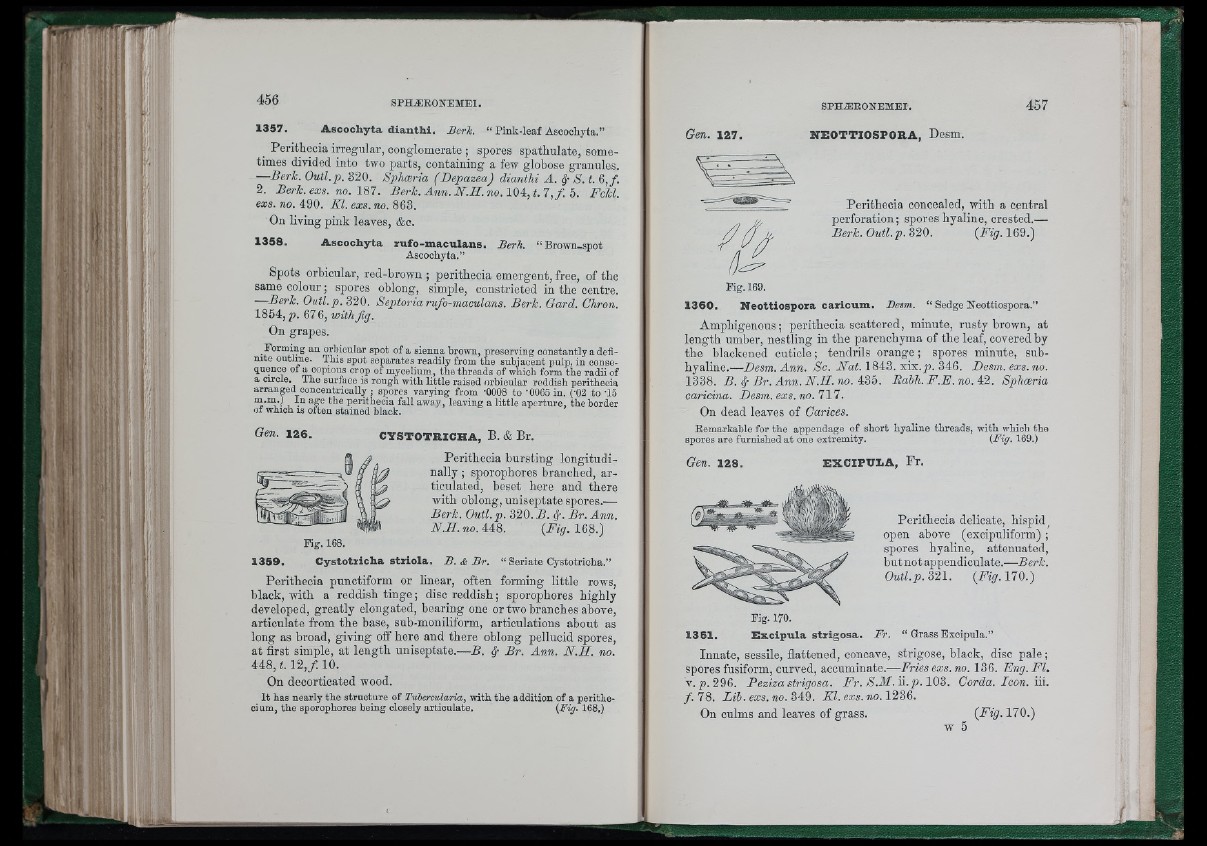
1 3 5 7 . A s c o ch y ta d ia n th i. Berk. “ Pink-leaf Ascochyta,”
_ Perithecia irregular, conglomerate ; spores spathulate, sometimes
divided into two parts, containing a few globose granules.
—Berh. Outl. p. 320. Sphoeria (Depazea) dianthi A. / S. t. 6 ,/.
2. Berh. exs. no. 187. Berh. Ann. N .H .n o .104, t.7 , f . 5. FcU.
exs. no. 490. Kl. exs. no. 863.
On living pink leaves, &c.
1 3 5 8 . A s c o c h y ta z u fo -m a c u la n s . Berk. “ Brown-spot
Ascochyta.”
Spots orbicular, red-brown ; perithecia emergent, free, of the
same colour ; spores oblong, simple, constricted in tbe centre.
—Berh. Outl.p. 320. Septoria rufo-maculans. Berh. Gard. Chron.
1854, p. 67 6, with fig.
On grapes.
Forming an orbicular spot of a sienna brown, preserving constantly a definite
outline. This spot separates readily from the subjacent pulp, in consequence
ot a copious crop of mycelium, the threads of which form the radii of
a circle, ih e surface is rough with little raised orbicular reddish perithecia
a rra n p d oonoentrioally ; spores varying from '0008 to ’0065 in. ('02 to -15
m.m.) In age the perithecia fall away, leaving a little aperture, the border
of which IS often stained black.
Gen. 1 2 6 . CYSTOTRICHA, B. & Br.
Perithecia bursting longitudinally
; sporophores branched, articulated,
beset bere and tbere
with oblong, nniseptate spores.—
Berh. Outl. p. 320. B . / . Br. Ann.
N.H . no. 448. (D « / 168.)
1 3 5 9 . C y sto tr ich a s tr io la . B .A B r . “ Seriate Cystotrioha.”
Perithecia punctiform or linear, often formmg little rows,
black, witb a reddisb tinge ; disc reddisb ; sporophores highly
developed, greatly elongated, bearing one or two branches above,
articulate from the base, sub-moniliform, articulations about as
long as broad, giving off bere and there oblong pellnoid spores,
at first simple, at length nniseptate.—B. / Br. Ann. N .H . no.
448,t. 1 2 , / 10.
On decorticated wood.
I t has nearly the structure of Tubercularia, with the addition of a perithecium,
the sporophores being closely articulate. (Fig. 168.)
Gen. 1 2 7 .
S P H Æ E O N E M E I .
NEO TTIOSFO RA , Desm.
Perithecia concealed, witb a central
perforation; spores hyaline, crested.—
Berh. Outl.p. 320. {F ig .169.)
F ig .169.
1 3 6 0 . N e o ttio sp o z a c a z icum . Besm. “ Sedge Neottiospora.”
Amphigenous; perithecia scattered, minute, rusty brown, at
length umber, nestling in tbe parenchyma of the leaf, covered by
the blackened cuticle ; tendrils orange ; spores minute, subhyaline.—
Desm. Ann. Sc. Nat. 1843. A x .p . 346. Desm. exs.no.
1338. B. 4 Br. Ann. N .II. no. 435. Babh. F .F . no. 42. Sphoeria
caricina. Desm. exs. no. 717.
On dead leaves of Carices.
Remarkable for the appendage of short hyaline threads, with which the
spores are furnished at one extremity. (Fig. 169.)
Gen. 1 2 8 . EX C IFV LA , Pr.
Perithecia delicate, hispid,
open above (excipuliform) ;
spores hyaline, attenuated,
but not appendicuiate.—--Béri*.
O u tl.p .321. {F ig .170.)
Fig. 170.
1 3 6 1 . E x c ip u la stz ig o sa . Fr. “ Grass Excipula.”
Innate, sessile, flattened, concave, strigose, black, disc pale ;
spores fusiform, curved, accuminate.— Fries exs. no. 136. Eng. F l.
Y . p . 296. Peziza strigosa. Fr. S .M . i i .p .103. Corda. Icon. iii.
f .7 8 . Lib. exs. no. 349. Kl. exs. no. 1236.
On culms and leaves of grass. {Fig. 170.)
w 5